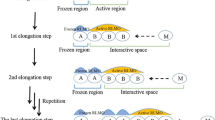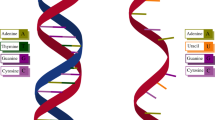Abstract
We present a computational study of convergence properties of vibrational IR and Raman spectra for a series of increasingly long units of polyethylene, cis- and trans-polyacetylenes, and polyynes. Convergent behavior to the spectra of infinitely long polymers was observed in all cases when chains reached lengths of approximately 60 carbon atoms, both with respect to the positions of the bands and to their intensities. The vibrational spectra of longer chains are practically indistinguishable. The convergence rate depends on the degree of the π conjugation in a studied system: Vibrational spectra for oligoethylenes converge noticeably faster than the spectra for the conjugated systems. The slowest convergence is observed for skeletal motions of the oligomer chains, which may require more than a hundred carbon atoms in the chain to show deviations smaller than 1 cm−1 to the corresponding solid-state calculations. The results suggest that the boundary between the properties of finite and infinite molecular systems fades away for a surprisingly small number of atoms.






Similar content being viewed by others
References
Aljibury AL, Snyder RG, Strauss HL, Raghavachari K (1986) The structure of n-alkanes: high precision ab initio calculation and relation to vibrational spectra. J Chem Phys 84:6872–6878
Kofranek M, Lischka H, Karpfen A (1992) From butadiene to polyacetylene: an ab initio study on the vibrational spectra of polyenes. J Chem Phys 96:982–996
Yang S, Kertesz M, Zolyomi V, Kurti J (2007) Application of a novel linear/exponential hybrid force field scaling scheme to the longitudinal Raman active mode of polyyne. J Phys Chem A 111:2434–2441
Yang S, Kertesz M (2008) Linear Cn clusters: are they acetylenic or cumulenic? J Phys Chem A 112:146–151
Choi CH, Kertesz M (1997) The effects of electron correlation on the degree of bond alternation and electronic structure of oligomers of polyacetylene. J Chem Phys 107:6712–6721
Pulay P (1995) Analytical derivative techniques and the calculation of vibrational spectra. In: Yarkony D (ed) Modern electronic structure theory. Part II. World Scientific, Singapore, pp 1191–1240
Delgado-Venegas RI, Mejía-Rodríguez D, Flores-Moreno R, Calaminici P, Köster AM (2016) Analytic second derivatives from auxiliary density perturbation theory. J Chem Phys 145:224103
Flores-Moreno R, Köster AM (2008) Auxiliary density perturbation theory. J Chem Phys 128:134105
Li WF, Irle S, Witek HA (2010) Convergence in the evolution of nanodiamond Raman spectra with particle size: a theoretical investigation. ACS Nano 4:4475–4486
Elstner M, Porezag D, Jungnickel G, Elsner J, Haugk M, Frauenheim T, Suhai S, Seifert G (1998) Self-consistent-charge density-functional tight-binding method for simulations of complex materials properties. Phys Rev B 58:7260–7268
Eisler S, Slepkov AD, Elliott E, Luu T, McDonald R, Hegmann FA, Tykwinski RR (2005) Polyynes as a model for carbyne: synthesis, physical properties, and nonlinear optical response. J Am Chem Soc 127:2666–2676
Elstner M, Jalkanen KJ, Knapp-Mohammady M, Frauenheim T, Suhai S (2001) Energetics and structure of glycine and alanine based model peptides: approximate SCC-DFTB, AM1 and PM3 methods in comparison with DFT, HF and MP2 calculations. Chem Phys 263:203–219
Krüger T, Elstner M, Schiffels P, Frauenheim T (2005) Validation of the density-functional based tight-binding approximation method for the calculation of reaction energies and other data. J Chem Phys 122(1–5):114110
Elstner M, Frauenheim T, Kaxiras E, Seifert G, Suhai S (2000) A self-consistent charge density-functional based tight-binding scheme for large biomolecules. Phys Status Solidi B 217:357–376
Witek HA, Irle S, Morokuma K (2004) Analytical second-order geometrical derivatives of energy for the self-consistent-charge density-functional tight-binding method. J Chem Phys 121:5163–5170
Witek HA, Morokuma K (2004) Systematic study of vibrational frequencies calculated with the self-consistent-charge density-functional tight-binding method. J Comput Chem 25:1858–1864
Małolepsza E, Witek HA, Morokuma K (2005) Accurate vibrational frequencies using the self-consistent-charge density-functional tight-binding method. Chem Phys Lett 412:237–243
Witek HA, Morokuma K, Stradomska A (2005) Modeling vibrational spectra using the self-consistent-charge density-functional tight-binding method. II. Infrared spectra. J Theor Comput Chem 4:639–655
Witek HA, Morokuma K, Stradomska A (2004) Modeling vibrational spectra using the self-consistent-charge density-functional tight-binding method. I. Raman spectra. J Chem Phys 121:5171–5178
Małolepsza E, Witek HA, Irle S (2007) Comparison of geometric, electronic, and vibrational properties for isomers of small fullerenes C20–C36. J Phys Chem A 111:6649–6657
Małolepsza E, Lee YP, Witek HA, Irle S, Lin CF, Hsieh HM (2009) Comparison of geometric, electronic, and vibrational properties for all pentagon/hexagon-bearing isomers of fullerenes C38, C40, and C42. Int J Quantum Chem 109:1999–2011
Witek HA, Trzaskowski B, Małolepsza E, Morokuma K, Adamowicz L (2007) Computational study of molecular properties of aggregates of C60 and (16, 0) zigzag nanotube. Chem Phys Lett 446:87–91
Gaus M, Chou CP, Witek HA, Elstner M (2009) Automatized parametrization of SCC-DFTB repulsive potentials: application to hydrocarbons. J Phys Chem A 113:11866–11881
Witek HA, Irle S, Zheng G, de Jong W, Morokuma K (2006) Modeling carbon nanostructures with the self-consistent charge density-functional tight-binding method: vibrational spectra and electronic structure of C28, C60, and C70. J Chem Phys 125(1–15):214706
Kazachkin DV, Nishimura Y, Witek HA, Irle S, Borguet E (2011) Dramatic reduction of IR cross-sections for molecules adsorbed in single wall carbon nanotubes. J Am Chem Soc 129:8191–8198
Li WF, Andrzejak M, Witek HA (2012) Evolution of physical properties of conjugated systems. Phys Status Solidi B 249:306–316
Witek HA, Irle S (2016) Diversity in electronic structure and vibrational properties of fullerene isomers correlates with cage curvature. Carbon 100:484–491
Aradi B, Hourahine B, Frauenheim T (2007) DFTB+, a sparse matrix-based implementation of the DFTB method. J Phys Chem A 111:5678–5684
Chou CP, Li WF, Witek HA, Andrzejak M (2011) Vibrational spectroscopy of linear carbon chains. In: Nemes L, Irle S (eds) Spectroscopy, dynamics and molecular theory of carbon plasmas and vapors. World Scientific, Hackensack, pp 375–415
Shirakawa H, Ikeda S (1971) Infrared spectra of poly(acetylene). Polym J 2:231–244
Hirata S, Iwata S (1997) Density functional crystal orbital study on the normal vibrations of polyacetylene and polymethineimine. J Chem Phys 107:10075–10084
Lichtmann LS, Imhoff EA, Sarhangi A, Fitchen DB (1984) Resonance Raman spectra of cis (CH)x and (CD)x. J Chem Phys 81:168–184
Mulazzi E (1985) Polarized resonant Raman scattering spectra from stretched trans polyacetylene. Theory. Solid State Commun 55(9):807–810
Tiziani R, Brivio GP, Mulazzi E (1985) Resonant Raman scattering spectra of trans-(CD)x: evidence for a distribution of conjugation lengths. Phys Rev B 31(6):4015–4018
Tabata H, Fujii M, Hayashi S, Doi T, Wakabayashi T (2006) Raman and surface-enhanced Raman scattering of a series of size-separated polyynes. Carbon 44:3168–3176
Krimm S, Liang CY, Sutherland GBBM (1956) Infrared spectra of high polymers. II. Polyethylene. J Chem Phys 25:549–562
Nielsen JR, Woollett AH (1957) Vibrational spectra of polyethylenes and related substances. J Chem Phys 26:1391–1400
Nielsen JR, Holland RF (1961) Dichroism and interpretation of the infrared bands of oriented crystalline polyethylene. J Mol Spectrosc 6:394–418
Brown RG (1963) Raman spectra of polyethylenes. J Chem Phys 38:221–225
Hirata S, Iwata S (1998) Density functional crystal orbital study on the normal vibrations and phonon dispersion curves of all-trans polyethylene. J Chem Phys 108:7901–7908
Snyder RG (1967) A revised assignment of the B2g methylene wagging fundamental of the planar polyethylene chain. J Mol Spectrosc 23:224–228
Snyder RG (1969) Raman spectrum of polyethylene and the assignment of the B2g way fundamental. J Mol Spectrosc 31:464–465
Rakovic D, Stepanyan SA, Gribov LA, Panchenko YN (1982) The solution of the inverse spectroscopic problem for the IR spectra of trans- and cis-hexatrienes. J Mol Struct 90:363–377
Kim JY, Furukawa Y, Sakamoto A, Tasumi M (2002) Raman studies on the self-localized excitations in lightly and heavily doped trans-polyacetylene with sodium. J Phys Chem A 106:8876–8882
Hendra PJ, Agbenyega JK (1993) The Raman spectra of polymers, 1st edn, chap C. Wiley, Chichester, p 6
Hummel DO (1991) Atlas of polymer and plastics analysis, 3rd edn. Wiley-VCH, Munich
Khlifi M, Paillous P, Delpech C, Nishio M, Bruston P, Raulin F (1995) Absolute IR band intensities of diacetylene in the 250–4300 cm−1 region: implications for Titan’s atmosphere. J Mol Spectrosc 174:116–122
Shindo F, Benilan Y, Guillemin JC, Chaquin P, Jolly A, Raulin F (2003) Ultraviolet and infrared spectrum of C6H2 revisited and vapor pressure curve in Titan's atmosphere. Planet Space Sci 51:9–17
Shindo F, Benilan Y, Chaquin P, Guillemin JC, Jolly A, Raulin F (2001) IR spectrum of C8H2: integrated band intensities and some observational implications. J Mol Spectrosc 210:191–195
Nishimura Y, Lee YP, Irle S, Witek HA (2014) Critical interpretation of CH– and OH– stretching regions for infrared spectra of methanol clusters (CH3OH)n (n = 2–5) using self-consistent-charge density functional tight-binding molecular dynamics simulations. J Chem Phys 141:094303
Acknowledgments
Ministry of Science and Technology, Taiwan (MOST 105-2113-M-009-018-MY3) and the Center for Emergent Functional Matter Science of National Chiao Tung University from the Featured Areas Research Center Program within the framework of the Higher Education Sprout Project funded by the Ministry of Education, Taiwan. We are grateful to the National Center for High-performance Computing, Taiwan for computer time and facilities.
Author information
Authors and Affiliations
Corresponding authors
Additional information
This paper belongs to Topical Collection International Conference on Systems and Processes in Physics, Chemistry and Biology (ICSPPCB-2018) in honor of Professor Pratim K. Chattaraj on his sixtieth birthday
Rights and permissions
About this article
Cite this article
Chou, CP., Witek, H. & Irle, S. When finite becomes infinite: convergence properties of vibrational spectra of oligomer chains. J Mol Model 24, 288 (2018). https://doi.org/10.1007/s00894-018-3824-3
Received:
Accepted:
Published:
DOI: https://doi.org/10.1007/s00894-018-3824-3




